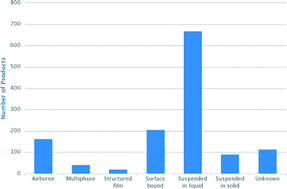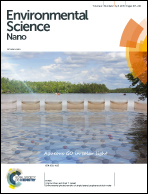Potential exposure and treatment efficiency of nanoparticles in water supplies based on wastewater reclamation
Abstract
Water scarcity brings an increased focus on wastewater reclamation for drinking water supply. Meanwhile, the production volume of nanoparticles (NPs) is rapidly increasing, but to date there has been little attention given to the fate of NPs in water systems based on wastewater reclamation. We have investigated the possible concentrations of silver (Ag), titanium dioxide (TiO2), and zinc oxide (ZnO) nanoparticles in tap water for water supplies based on reclaimed wastewater. Tap water concentrations of the NPs were assessed by mass flow analyses of two typical wastewater reclamation concepts: 1) advanced membrane treatment and 2) bank infiltration, similar to systems established in Orange County, CA, USA and Berlin, Germany. The mass flow analyses are based on a literature review of known wastewater concentrations of NPs and removal efficiencies for the implemented treatment stages in two case systems. Few studies are available on the removal efficiencies of NPs by advanced water treatment processes with a majority of the identified studies focusing on removal efficiencies in wastewater treatment plants and fate in surface waters. The NP removal efficiency of several treatment processes is unknown at this stage. We found the worst case removal efficiencies for the two cases to be 97–99.97% for Ag-NPs, 91–99.2% for TiO2-NPs, and 92–93% for ZnO-NPs. The corresponding worst case concentrations in tap water for the advanced membrane treatment were 0.04 μg L−1 (Ag), 147 μg L−1 (TiO2), and 0.28 μg L−1 (ZnO). The concentration of ZnO-NPs also includes zinc ions, thus the concentration of ZnO-NPs is likely to be lower than that indicated here. The worst case removal by the wastewater reclamation bank infiltration system was predicted to lead to tap water concentrations of up to 3.3 μg L−1 (Ag), 13 μg L−1 (TiO2), and 0.25 μg L−1 (ZnO). Overall, it is found that the primary removal mechanisms of NPs are aggregation, sedimentation, coagulation, and biosorption; this supports observations that conventional biological treatment processes are likely to be effective barriers against NPs. Advanced treatment methods such as microfiltration and ultrafiltration can exhibit very low removal of ZnO-NPs or zinc ions due to dissolution of ZnO-NPs. There are marked knowledge gaps, and further research on NP fate in water treatment is encouraged.


 Please wait while we load your content...
Please wait while we load your content...